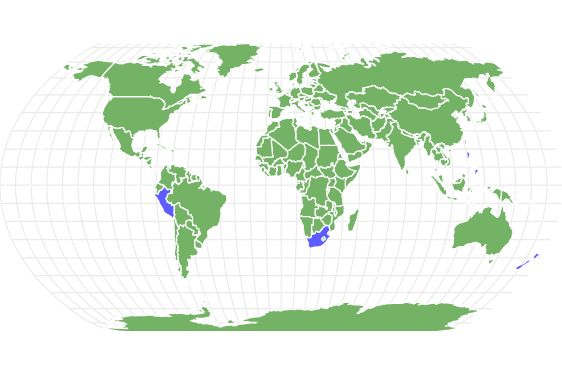Sea Snake
Hydrophiinae
The sea snake is incredibly venomous, even more than a cobra!”
Advertisement
Sea Snake Scientific Classification
- Kingdom
- Animalia
- Phylum
- Chordata
- Class
- Reptilia
- Order
- Squamata
- Family
- Elapidae
- Genus
- Hydrophis
- Scientific Name
- Hydrophiinae
Read our Complete Guide to Classification of Animals.
Sea Snake Conservation Status
Sea Snake Facts
- Prey
- Varous fish, eels, and fish eggs
- Main Prey
- Eels
- Fun Fact
- The sea snake is incredibly venomous, even more than a cobra!”
- Biggest Threat
- Humans eat sea snakes, and they are often exploited for their meat, organs, and skin.
- Most Distinctive Feature
- It's oar-like tail
- Litter Size
- 3 to 4
- Habitat
- Tropical, shallow waters
- Diet
- Carnivore
- Average Litter Size
- 3 to 4
- Favorite Food
- Eel
- Common Name
- Sea Snake
- Number Of Species
- 67
- Location
- Indian, and western Pacific Oceans
View all of the Sea Snake images!
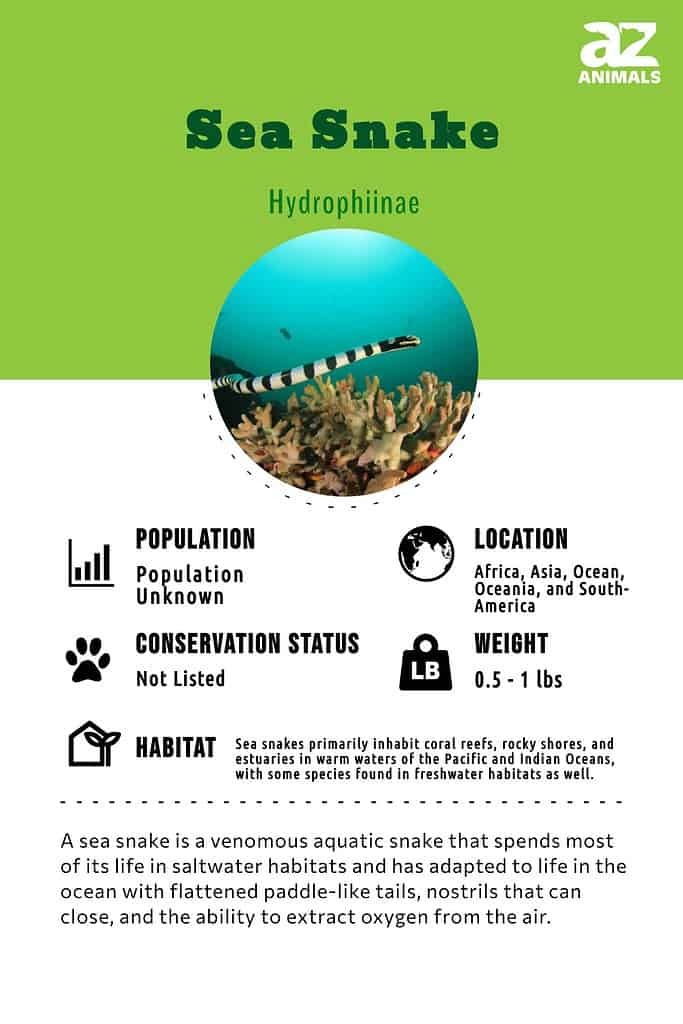
The sea snake is incredibly venomous, even more than a cobra!
There are over 60 species of sea snakes that belong to the same family as cobras, Elapidae. They are highly venomous and are divided into two groups.
Firstly, true sea snakes belong to the Hydrophiinae subfamily. In addition, they are related to Australian terrestrial elapids. The second group is sea kraits, belonging to the subfamily Laticaudinae and closely related to Asian cobras.
Sea snakes are venomous, and their toxins are very potent; however, if they do bite humans, fatalities are rare due to the small output of venom because their fangs are so short.
There are 55 species of true sea snakes that typically measure between 3.2 to 5 feet in length, but there are individuals that can grow up to 8 feet.
To adapt to their surroundings, sea snakes have flat bodies with short tails resembling an oar. In addition, they have valvular nostrils perched on top of their snouts and they have lungs that stretch through the entire length of their bodies.
Sea Snake Amazing Facts
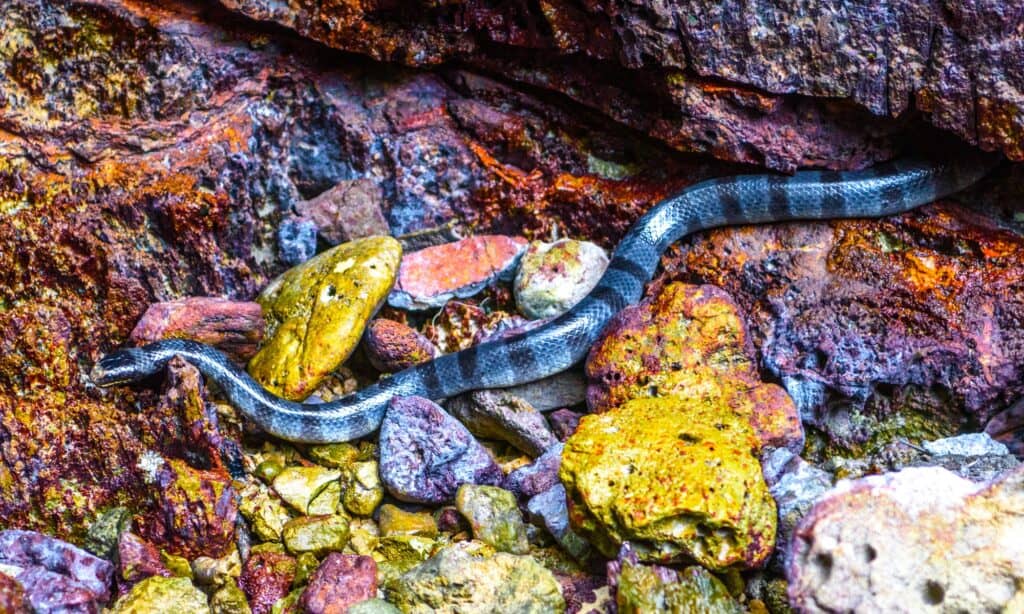
Sea snakes have a long history, with the first species emerging in the Coral Triangle of Southeast Asia between 6 and 8 million years ago.
©iStock.com/Eagle2308
- Sea snakes are ancient, with the first species evolving 6 to 8 million years ago in Southeast Asia’s Coral Triangle
- These marine snakes are the only reptiles to give birth in the ocean
- Sea snakes can die of thirst
- They are extremely venomous, but their bites are rarely fatal because their small fangs either don’t penetrate the skin through a wetsuit or don’t excrete enough venom.
- There are 69 species of sea snakes
While there are around 70 different species of sea snakes, here are some of the most common ones:
- Hydrophis platurus (yellow-bellied sea snake)
- Hydrophis cyanocinctus (blue-banded sea snake)
- Aipysurus duboisii (Dubois’ sea snake)
- Laticauda colubrina (banded sea krait)
- Hydrophis elegans (elegant sea snake)
- Hydrophis belcheri (Belcher’s sea snake)
- Aipysurus eydouxii (spine-bellied sea snake)
- Hydrophis obscurus (spotted sea snake)
- Aipysurus laevis (olive sea snake)
- Hydrophis melanocephalus (black-headed sea snake)
Evolution and Origins
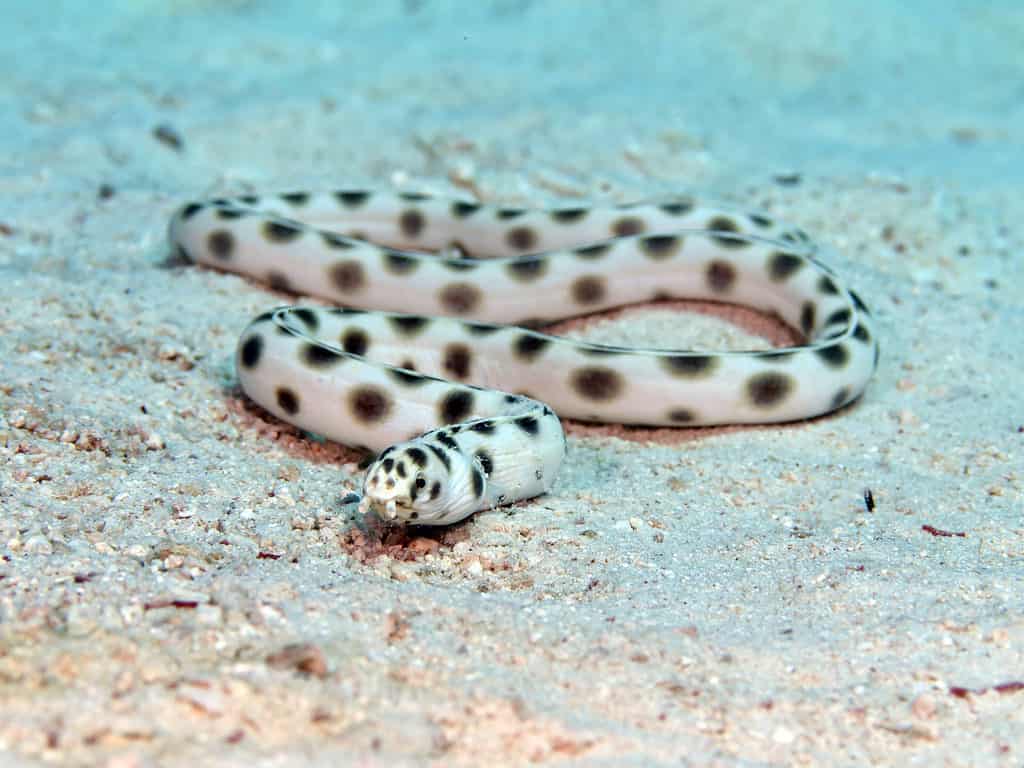
Between 2 to 16 million years ago, there was significant evolution and diversification of sea snakes in Southern Asia, resulting in the majority of the modern-day sea snake species found in this area.
©orlandin/Shutterstock.com
According to a recent study, there is no evidence regarding the specifics of when, where, and how often various species have developed their capacity to see colors, with sea snakes serving as an example: having entered the marine environment 15 million years ago, they have since been evolving in response to the ever-changing lighting conditions.
The majority of modern-day sea snakes underwent evolution and diversification in this geographical area around 2 to 16 million years ago, during a period when the region was a sizable wetland network linked to Southeast Asia and the Australasian archipelago.
Furthermore, the Coral Triangle in Southeast Asia was where the earliest sea snakes began to undergo evolution, around 6 to 8 million years ago, though the majority of sea snake species only began evolving between 1 to 3 million years ago.
Where to Find Sea Snakes
Sea snakes are found in coastal areas in the Western Pacific and Indian oceans and span from the eastern regions of Africa to the Gulf of Panama. However, some species live in the open ocean on the western coasts of the Americas, like the yellow-bellied sea snake.
But their preferred habitat is shallow water, not deeper than 100 feet (but they can go down to 300 feet) because they need to hunt on the sea bed among coral reefs. In addition, certain species prefer hunting on soft bottoms consisting of mud, and others prefer hard bottoms, like corals.
Some countries where you can find sea snakes include:
Types of Elapids
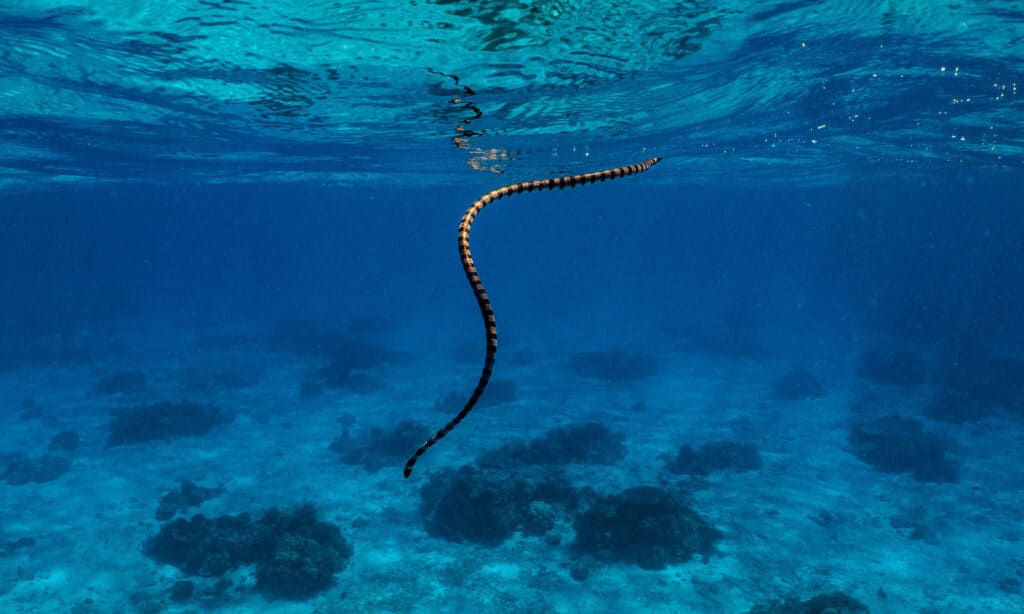
The sea snake belongs to the family Elapidae, which includes poisonous snakes with erect, permanently protruding fangs.
©SaltedLife/Shutterstock.com
The family Elapidae or Elapids are venomous snakes with permanently erect fangs, which include the sea snake. Most of the species in this family will react to a threat by rearing upwards and spreading their neck flap. They prefer warmer temperatures and occur in tropical and subtropical regions worldwide. Elapids vary in size and are generally neurotoxic. There are around 360 species in this family and over 170 subspecies, which include:
Cobra
Cobras come in all sizes and colors; some are yellow, black, red, banded, or mottled. They are generally large snakes, with many measuring more than 6 feet. The biggest true cobra is called the forest cobra and grows 10 feet long. In addition, Ashe’s spitting cobra is the largest spitting cobra, measuring 9 feet long.
On the other hand, the smallest species is the Mozambique spitting cobra that reaches 4 feet long when fully grown.
Lastly, the King cobra lives up to its name and is the longest of all venomous snakes measuring a whopping 18 feet long!
Mamba
Mambas occur in the rocky hills and savannas of eastern and southern Africa. They hold the title of Africa’s longest venomous snake, which reaches 14 feet when fully grown. In addition, they are super fast and can travel 12.5 miles per hour.
Tiger Snake
Tiger snakes derived their name because they have stripes resembling a tiger, but not all have a striped pattern.
Being bitten by a tiger snake is very dangerous because they are one of the most venomous snakes on the planet, and its fangs measure between 0.14 to 0.20 inches.
They are great swimmers and glide through the water with ease. When threatened, the tiger snake will stand at attention and flatten their heads, similar to a cobra.
Scientific Name
The Sea snakes’ scientific name is Hydrophiinae, and they belong to the family Elapidae. In addition, sea snakes fall under the class Reptilia. Most sea snakes fall into this category, but they are not the only ones. It also includes many species of venomous snakes like:
- Taipans
- Tiger Snakes
- Brown Snakes
- Death Adders
Population and Conservation Status
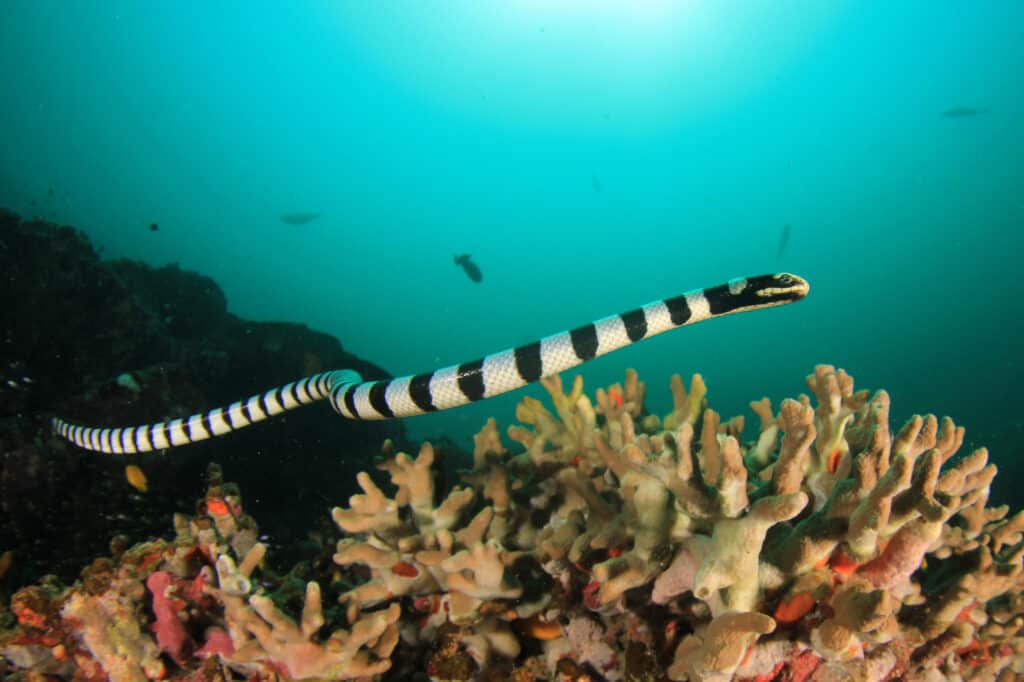
Due to the large number of sea snake species, it is challenging to determine their population size and conservation status as a whole.
©Rich Carey/Shutterstock.com
Because there are so many species of sea snakes, it’s hard to estimate their population size and conservation status under one umbrella. However, there are several species of sea snake on IUCN’s Redlist listed as Endangered.
For example, the Dusky sea snake shows up as Endangered, while the Crocker’s sea snake is listed as Vulnerable. Sadly, two species are listed as Critically Endangered: the Short-nosed and Leaf-scaled sea snake.
Appearance and Description
Sea snakes come in various sizes and colors. However, most of them measure between 4 to 5 feet long and usually have distinct ring patterns.
Similar to most snakes, they are long and slender, but their tails are unique because they are flat, and the tip of the tail resembles a paddle, which helps with swimming.

Sea snakes come in various colors and they usually have distinct ring patterns, like this blue-banded sea krait.
©Bramadi Arya / CC BY-SA 4.0 – License
Reproduction and Lifespan
Sea snakes are typically ovoviviparous, except for a single genus, the Sea Krait, which is oviparous, and includes 5 species that lay their eggs on land. Ovoviviparous is when the eggs are kept in the uterus until they hatch.
The females give birth to live young, who are generally quite large (sometimes half the length of the mother). Generally speaking, sea snakes can live for about ten years.
Venom: How Dangerous are They?

The largest sea snake to have existed could eat whale calves
©Nobu Tamura (http://spinops.blogspot.ca/) / Creative Commons – License
The sea snake is incredibly venomous, even more than a cobra! Their venom is a deadly combination of myotoxins and neurotoxins. Luckily, there haven’t been many recorded sea snake bites, and those that did get bitten all lived. Sea snakes rarely deliver venom when attacking due to their small fangs.
Sometimes the bite is painless, and no symptoms occur. However, a few small teeth can remain behind in the wound.
But, when symptoms appear, it takes anywhere from 30 minutes to several hours. They can include:
- Thirst
- Headaches
- Vomiting
- Stiffness
- Sweating
- Muscle pain
- Swollen tongue
Eventually, muscle degradation and paralysis kick in, and it can be fatal if the poison starts to affect the muscles involved in swallowing and respiration. Unfortunately, antivenom is almost impossible to find because sea snake bites are few and far between.
Behavior and Humans
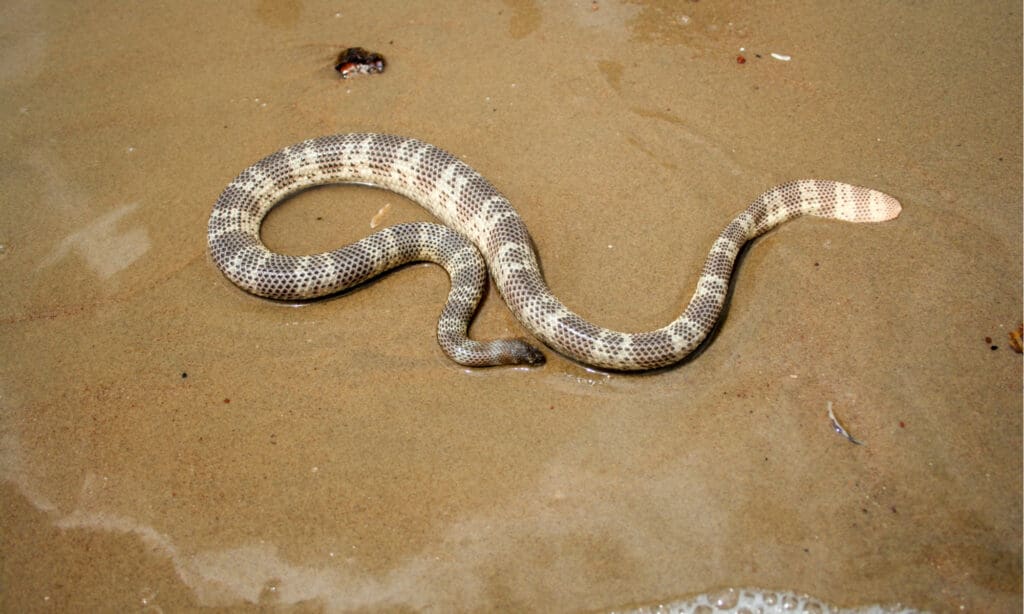
Sea snakes are extremely cautious animals that would rather flee from danger.
©IHX/Shutterstock.com
Sea snakes are very timid creatures and would rather retreat in the face of danger. They are completely opposite from the cobra’s aggressive nature, even though they belong to the same family.
Humans eat sea snakes, and they are often exploited for their meat, organs, and skin. Unfortunately, CITES has yet to protect sea snakes even though they are often taken in great numbers.
The Philippines was one of the biggest culprits because the sea snake’s meat has been used commercially since 1934. Eventually, it was necessary to implement local protection to avoid over-exploitation.
Other countries to exploit sea snakes are:
Australia has since implemented special licenses to fish for sea snakes; however, there are many areas where they occur that are not controlled by governments and can not be monitored around the clock.
But their biggest threat is climate change, low reproduction rates, and bycatch, and these factors are killing their population numbers.
They have many predators and always need to be on the lookout, both from above and below. These predators include:
- Sharks
- Eels
- Sea Eagles
- Large bony fish
Sea Snake FAQs (Frequently Asked Questions)
How fast is a sea snake?
Sea snakes can swim 2 – 2.5 mph.
How toxic is a sea snake?
The sea snake is incredibly venomous, even more than a cobra! Their venom is a deadly combination of myotoxins and neurotoxins.
What do sea snakes eat the most?
Sea snakes usually prey on fish, eels, and fish eggs.
How big is a sea snake?
Sea snakes come in various sizes and colors. However, most of them measure between 4 to 5 feet long and usually have distinct ring patterns.
Do sea snakes have teeth?
Yes, however, sea snakes rarely deliver venom when attacking due to their small fangs.
Thank you for reading! Have some feedback for us? Contact the AZ Animals editorial team.
Sources
- Sea World, Available here: https://seaworld.org/animals/facts/reptiles/sea-snakes/
- Britannica, Available here: https://www.britannica.com/animal/sea-snake
- PADI, Available here: https://blog.padi.com/sea-snake-facts/
- Wikipedia, Available here: https://en.wikipedia.org/wiki/Sea_snake#Distribution_and_habitat
- Study, Available here: https://study.com/academy/lesson/sea-snake-facts-lesson-for-kids.html

